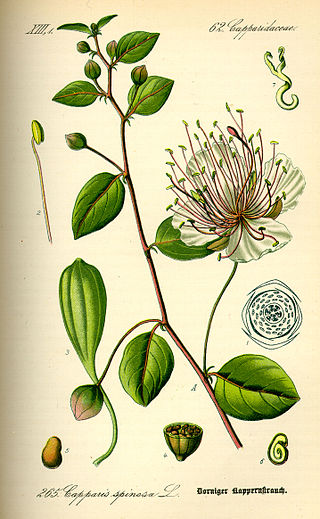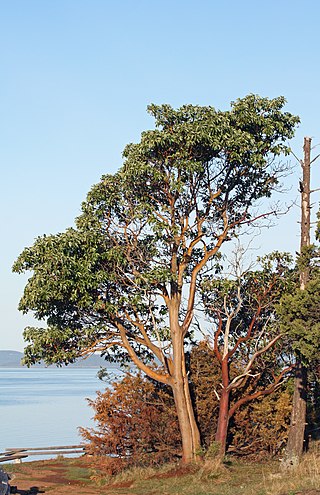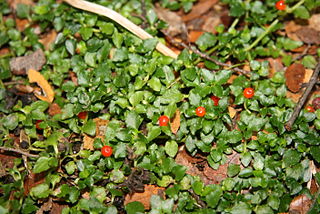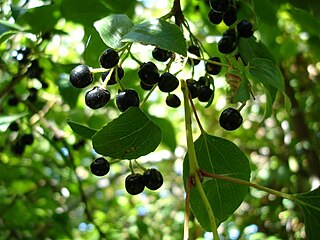
Mahonia aquifolium, the Oregon grape or holly-leaved barberry, is a species of flowering plant in the family Berberidaceae, native to western North America. It is an evergreen shrub growing 1–3 meters tall and 1.5 m (5 ft) wide, with pinnate leaves consisting of spiny leaflets, and dense clusters of yellow flowers in early spring, followed by dark bluish-black berries.

Capparis spinosa, the caper bush, also called Flinders rose, is a perennial plant that bears rounded, fleshy leaves and large white to pinkish-white flowers.

Fouquieria splendens is a plant indigenous to the Sonoran Desert and Chihuahuan Desert and Colorado Desert in the Southwestern United States, and northern Mexico.

Arbutus menziesii or Pacific madrone, is a species of broadleaf evergreen tree in the family Ericaceae, native to the western coastal areas of North America, from British Columbia to California. It is nicknamed the "Refrigerator Tree" due to the fact that its bark contains water, and it stays cool in the summer

Aronia is a genus of deciduous shrubs, the chokeberries, in the family Rosaceae native to eastern North America and most commonly found in wet woods and swamps. The genus Aronia is considered to have 3 species. The most common and widely used is Aronia melanocarpa which emerged from Eastern North America. The lesser known Aronia arbutifolia and the hybrid form of the abovementioned species called Aronia prunifolia were first cultivated in Central and Eastern North America. In the eighteenth century, the first shrubs of the best-known species Aronia melanocarpa reached Europe where they were first cultivated in Scandinavia and Russia.

A tropical garden is a type of garden that features tropical plants and requires heavy rainfall or a decent irrigation or sprinkler system for watering. These gardens typically need fertilizer and heavy mulching.

Ilex verticillata, the winterberry, is a species of holly native to eastern North America in the United States and southeast Canada, from Newfoundland west to Ontario and Minnesota, and south to Alabama.

Heteromeles arbutifolia, commonly known as toyon, is a common perennial shrub native to extreme southwest Oregon, California, and the Baja California Peninsula. It is the sole species in the genus Heteromeles.

Pandanus tectorius is a species of Pandanus (screwpine) that is native to Malesia, Papuasia, eastern Australia, and the Pacific Islands. It grows in the coastal lowlands typically near the edge of the ocean. Common names in English include thatch screwpine, Tahitian screwpine, hala tree and pandanus. The edible fruit is sometimes known as hala fruit.

Nertera is a genus of about 15 species of flowering plants in the family Rubiaceae, native to the Southern Hemisphere, in South America and Australasia, with one species extending into the Northern Hemisphere in Central America, eastern Asia, and Hawaii. The name derives from the Greek word nerteros, meaning low down. Common names include pincushion, coral bead or bead plant. They are prostrate, creeping, mat-forming herbaceous perennial plants growing to 20–40 cm (7.9–15.7 in) across or more but no more than a few centimetres high. The leaves are usually quite small, and when crushed may in some species release a foul smell (methanethiol) like the related woody genus Coprosma. The flowers are insignificant and probably wind-pollinated. The fruit is usually a bright orange berry, but in some species may be a dry capsule.

Dioscorea elephantipes, the elephant's foot or Hottentot bread, is a species of flowering plant in the genus Dioscorea of the family Dioscoreaceae, native to the dry interior of South Africa.

Carmona is a genus of flowering plants in the borage family, Boraginaceae. Members of the genus are commonly known as scorpionbush.

Acalypha hispida, the chenille plant, is a flowering shrub which belongs to the family Euphorbiaceae, the subfamily Acalyphinae, and the genus Acalypha. Acalypha is the fourth largest genus of the family Euphorbiaceae, and contains many plants native to Hawaii and Oceania.

Mahonia trifoliolata is a species of flowering plant in the family Berberidaceae, in southwestern North America. Common names include agarita, agrito, algerita, currant-of-Texas, wild currant, and chaparral berry. The name Agarita comes from the Spanish verb agarrar, which means "to grab". The ending "-ita" is often added to little things, so agarita means "grabs a little". This was probably said because the bush is a bit scratchy but does not have significant spines. Typical characteristics are grey-green to blue-grey leaves, yellow flowers in February to April and the red berries appearing in May. The most important harvest organ are the berries, though the roots and seeds can also be used.

Aristotelia chilensis, known as maqui or Chilean wineberry, is a tree species in the Elaeocarpaceae family native to South America in the Valdivian temperate rainforests of Chile and adjacent regions of southern Argentina. Limited numbers of these trees are cultivated in gardens for their small fruits. Wild-harvested fruits are commercially marketed.

Grevillea johnsonii, commonly known as Johnson's grevillea or Johnson's spider flower, is a species of flowering plant in the family Proteaceae and is endemic to New South Wales. It is a shrub with divided, needle-like leaves and red to orange flowers, and grows in rocky places.

Tecophilaea cyanocrocus, the Chilean blue crocus, is a flowering perennial plant that is native to Chile, growing at 2,000 to 3,000 m elevation on dry, stony slopes in the Andes mountains. Although it had survived in cultivation due to its use as a greenhouse and landscape plant, it was believed to be extinct in the wild due to overcollecting, overgrazing, and general destruction of habitat, until it was rediscovered in 2001.

Allium bisceptrum, also known as the twincrest onion or aspen onion, is a high elevation plant native to western United States. It is a perennial that thrives under damp and shady conditions or open meadows in California, Arizona, New Mexico, Nevada, Oregon, Washington, Idaho, and Utah.

Tradescantia sillamontana is a perennial evergreen herbaceous plant of the genus Tradescantia. This species is one of the most succulent and xerophytic, but at the same time one of the most attractive species of Tradescantia. It is endemic to dry areas of the State of Nuevo León in northeastern Mexico and can also be found in Spain and Italy.

Crassula ovata, commonly known as jade plant, lucky plant, money plant or money tree, is a succulent plant with small pink or white flowers that is native to the KwaZulu-Natal and Eastern Cape provinces of South Africa, and Mozambique; it is common as a houseplant worldwide. Much of its popularity stems from the low levels of care needed; the jade plant requires little water and can survive in most indoor conditions. It is sometimes referred to as the money tree; however, Pachira aquatica also has this nickname.





















